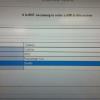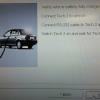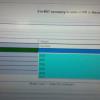Case Study
2002 Cadillac DeVille
ABS light on, Traction Control light on, Brake Warning light on
Codes C1248 – C1255
No communication with EBCM (Electronic Brake Control Module)
 I always try to keep the diagnostic side as
I always try to keep the diagnostic side as
simple as possible. You know, do the basics, get
the codes, do the research and do it all as fast
as possible. To start this project the first thing
to establish is the same with any electronic
diagnostics, that’s powers and grounds. All the
fuses were good, and since there was perfect
communication with the rest of the car the
next best place to go is straight to the EBCM
connector and check for any connection
problems or faulty wiring. Everything checks
out prefect. I’m leading towards a faulty
EBCM at this point.
Scanner Readings
Codes are useful, but bidirectional control and
other functions of a good scanner can be even
more helpful when diagnosing something like this.
For this era of GM products I use a Tech II to
diagnose them. I like to run the “automated test”
in the ABS list of options as per the diagnostic tree
instructions. This allows a basic self-test of
the EBCM functions. However, this particular
car only showed on the Tech II that the “relay”
was not on. Following the wiring diagrams
showed the “relay” is actually internal to the
EBCM. Another strike for a faulty EBCM.
EBCM Functions
This vehicle is equipped with several braking
systems.
Antilock Brake System (ABS)
Dynamic Rear Proportioning (DRP)
Traction Control System (TCS)
Vehicle Stability Enhancement System (VSES)
(w/JL4)
All of these systems work within the EBCM.
The Brake Pressure Modulator Valve (BPMV)
contains the hydraulic valves and pump motor
that are controlled by the EBCM. All the
wheel speed sensors produce an AC signal as
the wheel spins. The EBCM uses this signal to
calculate the wheel speed. (Except for models
with B9Q or V4U)
Note: The front wheel speed sensors are part
of the hub assembly, while the rear speed
sensors and tone rings can be purchased
separately.
The Yaw sensor (w/JL4) is read by the EBCM as
an indication of the tilt or “yaw” of the vehicle.
The steering wheel position sensor (SWPS) is
read by the EBCM to indicate the steering
wheel rotation and position.
The EBCM performs an initialization test at the
start of every ignition cycle. This initialization
sequence cycles each solenoid valve and pump
motor for approximately 1.5 seconds. That’s why
the warning lights stay on for 1.5 seconds after
start up. If the EBCM detects an error it will set
a code and the warning lights will remain on.
Onto the Repair
 With the wiring checked, the codes verified, and the lack of communication it’s safe to assume the culprit is the EBCM itself.
With the wiring checked, the codes verified, and the lack of communication it’s safe to assume the culprit is the EBCM itself.
 After replacing the EBCM you’re not done yet. It needs programmed. Yes, another typical system that can’t self-start without having the latest greatest program entered into it. Even after replacing the EBCM the warning lights will be on, and there will be codes stored as well. In this case the exact same two codes I had before. (A little disturbing) the only difference is the C1255 code has some extra digits added. This time it is C1255m3. The m3 indicates that it is not a programmed EBCM. (How nice of GM to do that.)
After replacing the EBCM you’re not done yet. It needs programmed. Yes, another typical system that can’t self-start without having the latest greatest program entered into it. Even after replacing the EBCM the warning lights will be on, and there will be codes stored as well. In this case the exact same two codes I had before. (A little disturbing) the only difference is the C1255 code has some extra digits added. This time it is C1255m3. The m3 indicates that it is not a programmed EBCM. (How nice of GM to do that.)
Onto Programming
 This is where my diagnostic information left me hanging. (At least with the system I use.) Obviously it needs programmed, that was clearly established with the addition of the “m3” to the codes, but where to go next? In fact the only information given was “Preform the setup procedure for the EBCM” - “Refer to the Techline Terminal/Equipment user’s instructions”. I spent a great deal of time going through page after page of misleading information until I found the correct procedures.
This is where my diagnostic information left me hanging. (At least with the system I use.) Obviously it needs programmed, that was clearly established with the addition of the “m3” to the codes, but where to go next? In fact the only information given was “Preform the setup procedure for the EBCM” - “Refer to the Techline Terminal/Equipment user’s instructions”. I spent a great deal of time going through page after page of misleading information until I found the correct procedures.
Actual Programming
 If you’re using a Tech II you should also be familiar with the TIS 2000 program. You’ll need both in order to perform the programming. If you’ve reconfigured a BCM with a Tech II you know that there is a heading for the BCM, but look all you want for the EBCM it’s not there.. This program is located on in the TIS program only. And, it is not a straight forward transfer to the Tech II like you would do with reprogramming a PCM. This time around you have to bring the laptop to the car and hook the Tech II up as a pass through device. It can only be done by way of the “Pass through” section of the TIS program.
If you’re using a Tech II you should also be familiar with the TIS 2000 program. You’ll need both in order to perform the programming. If you’ve reconfigured a BCM with a Tech II you know that there is a heading for the BCM, but look all you want for the EBCM it’s not there.. This program is located on in the TIS program only. And, it is not a straight forward transfer to the Tech II like you would do with reprogramming a PCM. This time around you have to bring the laptop to the car and hook the Tech II up as a pass through device. It can only be done by way of the “Pass through” section of the TIS program.
 Once you have located the appropriate software by following the guidelines outlined in the TIS program it only takes one click to start the download. It should only take a few seconds. When it says “complete” you’ll notice the warning lights on the dash have all gone out. Cycle the key on off, and disconnect the scanner.
Once you have located the appropriate software by following the guidelines outlined in the TIS program it only takes one click to start the download. It should only take a few seconds. When it says “complete” you’ll notice the warning lights on the dash have all gone out. Cycle the key on off, and disconnect the scanner.
 At this point all the codes should have erased from memory providing there are no additional problems with any other part of the ABS or traction control system.
At this point all the codes should have erased from memory providing there are no additional problems with any other part of the ABS or traction control system.
 As it seems to be the norm, a lot of times the information you have will lack one or two vital steps for you to complete the job. Then you spend even more frustrating hours trying to figure out how to accomplish that missing step. It took me hours to find the proper route to get this program installed. Hopefully after reading this you won’t have the same problem as I did the first time I tried to reprogram one. (Note: A lot of the newer cars are pass through only, so get used to doing this step.)
As it seems to be the norm, a lot of times the information you have will lack one or two vital steps for you to complete the job. Then you spend even more frustrating hours trying to figure out how to accomplish that missing step. It took me hours to find the proper route to get this program installed. Hopefully after reading this you won’t have the same problem as I did the first time I tried to reprogram one. (Note: A lot of the newer cars are pass through only, so get used to doing this step.)
 Keep scanning, keep programming, the more you work with it the easier it will be.
Keep scanning, keep programming, the more you work with it the easier it will be.



